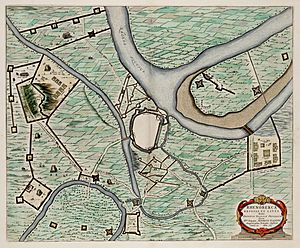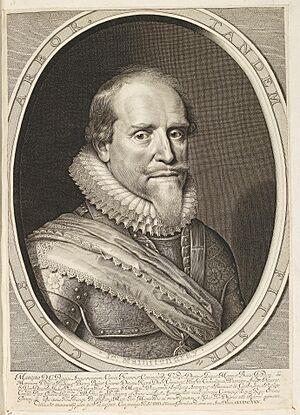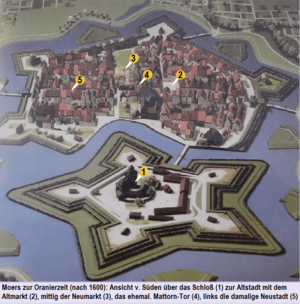Siege of Rheinberg (1601) facts for kids
Quick facts for kids Siege of Rheinberg (1601) |
|||||||
|---|---|---|---|---|---|---|---|
| Part of the Eighty Years' War & the Anglo–Spanish War | |||||||
 Siege of Rheinberg 1601 from the Atlas Van Loon |
|||||||
|
|||||||
| Belligerents | |||||||
| Commanders and leaders | |||||||
| Strength | |||||||
| 10,000 | 3,000 (Rheinberg) 5,200 (Relief) |
||||||
| Casualties and losses | |||||||
| 400 killed or wounded | ~3,500 killed, wounded, or captured | ||||||
The siege of Rheinberg, also known as the Rhine campaign of 1601, was an important battle during the Eighty Years' War and the Anglo–Spanish War. It took place from June 12 to August 2, 1601. During this time, the towns of Rheinberg and Meurs were under attack.
Maurice of Orange, leading an army of Dutch and English soldiers, surrounded these Spanish-held cities. His main goal was to distract the Spanish forces. This would make it harder for the Spanish to attack Ostend, another important city. Rheinberg was a very important city. It finally gave up on July 28 after a Spanish army, led by Herman van den Bergh, failed to help the city. The towns of Meurs surrendered soon after.
Why the Battle Happened
In the middle of 1601, Albert of Austria was getting ready to attack Ostend. Ostend was held by Dutch and English troops. At the same time, the States General (the Dutch government) told Maurice of Orange to go help Ostend. Maurice was the stadtholder, a leader in the Dutch Republic.
Francis Vere, the English governor of Ostend, was worried. He felt the Dutch were not responding fast enough. Some experienced English soldiers were even moved from Ostend to join Maurice's army. Maurice knew that a direct attack on the Spanish might not work. So, he chose to fight in areas closer to the heart of the Dutch Republic. This plan aimed to stop Spanish supplies. It also hoped to make the Spanish focus on Maurice, instead of Ostend.
On June 7, Maurice set up his camp with about 10,000 soldiers. He marched towards the Rhine river. His army included 2,500 English soldiers. These English troops were led by Robert Bertie, Lord Willoughby. Maurice considered attacking Grave and 's-Hertogenbosch. But he chose Rheinberg instead. Rheinberg had been captured four times since 1589. It had a large Spanish army of over 3,000 skilled soldiers. These soldiers were from Spain and led by Don Luis Bernardo de Avila. They also had plenty of supplies for a long fight.
The Fight for Rheinberg
On June 10, 1601, Maurice's army began its march. Two days later, the Dutch and English soldiers surrounded Rheinberg. They quickly started digging trenches and building walls around the town. These were called siege works. However, within a few days, Maurice received new orders. He had to send almost 2,000 of his soldiers to help Ostend. This included many of his best English and Scottish troops. Maurice was worried about his shrinking army. He hoped the town would give up before he lost more soldiers.
On June 29, Henry Percy, 9th Earl of Northumberland and other important people came to Rheinberg. They wanted to learn about siege warfare. For a short time, Percy took command of the English forces. This caused some disagreements with the English commander, Lord Willoughby. On July 5, the siege of Ostend began. Soon after, Percy visited Ostend to learn more. Lord Willoughby then took back command of the English troops.
Meanwhile, Count Herman van den Bergh marched from Spanish Flanders. He had 5,000 soldiers and 2,000 horsemen. He hoped to help the Spanish in Rheinberg. But as he got closer, his leading troops checked the defenses. They found Maurice's siege works were very strong. After an attack was stopped, van den Bergh realized he couldn't break through. He didn't want to risk a big battle. So, he decided to retreat, leaving the city to its fate.
Maurice's siege works were very effective. His engineers dug a mine (a tunnel) under the Kassel gate. On July 26, the mine was blown up. It caused a lot of damage and many deaths. One person who saw it said many people were thrown into the air. Maurice kept up his attacks. Three days later, more mines were placed in other areas. Luis De Avila, the Spanish commander, realized there was no hope left. He surrendered on July 30.
After leaving some soldiers in Rheinberg, Maurice marched south to Meurs. They attacked Meurs on August 2, 1601. After a short bombing and no hope of help, the Spanish soldiers there quickly gave up.
What Happened Next
The victory was celebrated in Holland. A special medal was made to remember it. It had the words: the enemy threatening fearful things is driven from Berg.
Rheinberg was later attacked again in 1606 by Ambrogio Spinola. He captured it. Rheinberg stayed in Spanish hands until 1632. Then, Frederick Henry took the city back. It remained under Dutch control.
The Dutch decided to make both towns stronger with their own soldiers. They no longer trusted the German prince's soldiers to stay neutral. This meant the Dutch now controlled important areas like Cleves and Julliers. These areas had seen a difficult campaign by Francisco de Mendoza in 1599. Maurice then sent more soldiers to Ostend. He stopped fighting for two months. In November, he tried to take 's-Hertogenbosch. But a very cold winter and the threat of a Spanish army under Van den Bergh forced Maurice to stop fighting for the winter.
Meurs stayed under Dutch control. It remained part of the Dutch Republic until 1712. Then, it became part of Prussia.



